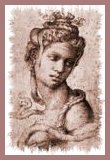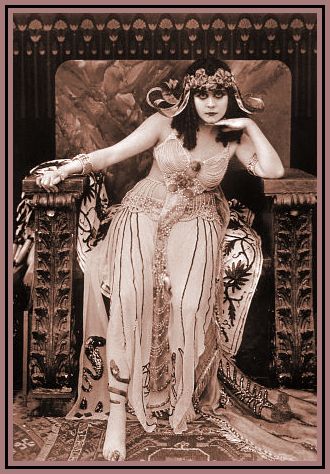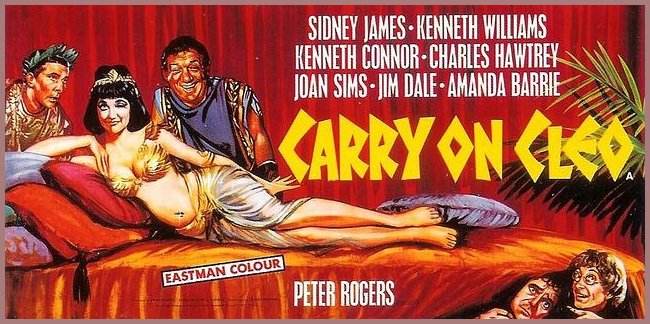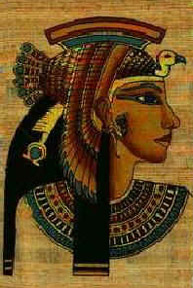
Entertainment Home / Home Page / Back to WKB
Carry On Cleo
Although this page is dedicated to the divine Amanda Barrie's portrayal of 'Cleopatra' the background portraiture is based on Michelangelo's (MIichelangelo di Lodovico Buonarroti Simoni) image of this great Egyptian ruler and queen. I could not have gone ahead without attributing this fact as, until just now, I had no idea that he had created a visual image of Cleopatra. I make the point because I studied Michelangelo for my History of Art qualifications.
Another Screen Goddess portraying Cleopatra

The sublime Theda Bara as 'Cleopatra' in 1917
Back to Carry On Cleo (1964)
The following has been reproduced from the British Film Industry Screen On-Line:
 Synopsis (warning 'Spoiler')
Synopsis (warning 'Spoiler')
(Mark Antony and Cleopatra's plans to overthrow Julius Caesar are continuously thwarted by two British slaves.)
In Ancient Britain, Hengist Pod makes a poor living as the maker of square wheels, much to the dismay of his shrewish wife Senna. He sells one of his wheels to Horsa, his new next-door neighbour, and the two become friends. Their settlement comes under attack from a Roman legion and Hengist is sent to get help from Boudicca's army in Carlisle. After his bicycle breaks, he tries to get a lift from a passing cart, but is captured by the Romans. Together with Horsa and others he is sent to Rome.
Mark Antony, the leader of the invading Roman army, goes to see Julius Caesar and update him on their progress. They are both unhappy about their lack of success and the bad weather. Caesar is recalled to Rome after three years away at war with news of possible treachery in the Senate. The population greets Caesar's return with disdain, as does his wife Calpurnia, who feels ignored by her husband. He brings her the gift of a British slave, Gloria, but she rejects the offer. Her father Seneca, however, is much more taken with her. Seneca warns Caesar to beware the ides of March and of plots against his life.
Horsa and Hengist are taken to the slave market run by the brothers Marcus and Spencius. After Horsa is sold at auction, the two manage to escape and hide out in the Temple of Vesta. Caesar arrives to consult the Virgins. Shortly after arriving, Caesar's bodyguard, Bilius, tries to kill him. Caesar and Hengist are knocked senseless and Horsa dispatches Bilius and the guards on his own. He manages to hide just before Mark Antony and his men arrive. Hengist is given the credit for saving Caesar's life and is made a centurion, replacing Bilius as Caesar's bodyguard. Mark Antony, however, remains unconvinced of his fighting skills.
Mark Antony is sent to Egypt to depose Cleopatra and return Ptolemy to the throne. However, he is soon bewitched by her charms and they quickly become lovers. He kills Ptolemy and leaves her on the throne. He plots with Cleopatra to overthrow Caesar and become the new Emperor. Mark Antony returns to Rome and tells Caesar that Cleopatra wishes to have a liaison with him. Caesar heads for Egypt accompanied by Mark Antony, Hengist, Seneca and Gloria. Horsa has been recaptured and is one of the galley slaves manning the oars on the ship. He and the others escape from their shackles and overwhelm the guards on the ship. Mark Antony has arranged for the ship's men to kill Caesar and Hengist is sent to fight them. He finds that Horsa and the other slaves have killed the rebels and have left the ship. Once again Hengist is given all the credit. Those remaining on board now have to row the ship all the way to Egypt.
Once the Romans have arrived in Alexandria, a soothsayer tells Caesar that Cleopatra will try to kill him when he goes to her chamber than night. Hengist and Caesar exchange clothes, unaware that Mark Antony is hiding under the bed waiting to stab Caesar. Hengist is so nervous about impersonating Caesar that he is given a potion that gives him great strength and courage. When he meets Cleopatra he jumps on her bed and inadvertently immobilises Mark Antony. He then fights Cleopatra's bodyguard, Sosages, before meeting up with Horsa. Together with Gloria they escape and return to Britain. Horsa and Gloria are married and, thanks to the potion, Hengist and his wife go on to have several children. Brutus and other members of the Roman Senate eventually assassinate Caesar, while Mark Antony stays on in Egypt to live with Cleopatra.
About 'Carry On Cleo'
Technical Stuff:
35mm / colour / 92 mins
Creditworthy Stuff
Director : Gerald Thomas
Production Company : Adder Productions
Producer : Peter Rogers
Screenplay : Talbot Rothwell
Based on an idea by : William Shakespeare
Photography : Alan Hume
Cast: (For Full Cast List see here)
Cleopatra : Amanda Barrie
Hengist Pod : Kenneth Connor
Julius Caesar : Kenneth Williams
Mark Antony : Sidney James
Calpurnia : Joan Sims
General
Although designed as a send-up of the historical epics that proliferated throughout the 1960s, Carry On Cleo more directly parodies the notoriously extravagant Hollywood blockbuster Cleopatra (UK/US, 1963). But the decision to lampoon this particular movie was made partly for practical reasons. Its star Elizabeth Taylor had originally insisted that Cleopatra be shot in the UK. However, after enormous delays the production relocated to Italy, leaving behind many unused costumes, props and sets in storage at Pinewood Studios, home of the Carry On films.
The film wittily contrasts the splendour of Ancient Rome with the prehistoric Britons dwelling in caves, with Kenneth Connor cast as Hengist Pod, inventor of the square wheel. In one of the film's most inspired sequences, Pod and his neighbour Horsa (played by Jim Dale) are captured and taken to Rome to be sold at a slave market run by the family firm, Marcus et Spencius. Splitting the focus between the honourable slaves and the dissolute Romans was a ploy derived from Quo Vadis (US, 1951) and Ben Hur (US, 1959), but also recalls the hit 1963 West End comedy A Funny Thing Happened on the way to the Forum, in which Frankie Howerd played a slave in ancient Rome and in which Connor was still appearing during the filming.
Although this is the Carry On film in which Sid James first comes to the fore, Amanda Barrie sparkles as a coquettish Cleopatra, while Kenneth Williams is a very eccentric Julius Caesar. Williams and James' regular greeting - "Tony!", "Julie!" - is priceless, while Talbot Rothwell's script is replete with cod schoolboy Latin (one of the best has James deliver an exasperated "Blimus!"), a plethora of puns and ingratiatingly daft lines. Particularly effective is the deadpan narration delivered by E.V.H. Emmett, known for thirty years as the voice of the Gaumont British newsreel.
Sergio Angelini
 Cleopatra (69 - 30 BC) - the Biography
Cleopatra (69 - 30 BC) - the Biography
With grateful thanks to Tigerx.com
One of the most fascinating women in history was Cleopatra VII, daughter of Isis and King Ptolemy the XII of Egypt. She has been portrayed as the Queen of Egypt in so many films, books, plays and is often a popular theme for Halloween costumes. She is noted for her great intelligence as well as beauty. Hollywood has often distorted many of the facts surrounding this remarkable woman and the history behind her.
Cleopatra had many interests including astronomy, alchemy, cosmetics and perfume and spoke as many as 9 languages. Being of Greek heritage and culture, it is often argued if she in fact had dark features like black hair and dark brown eyes, or blonde hair and blue eyes. One thing that is sure is she was from the Ptolemy line set on the throne of Egypt after the conquest of Alexander the Great. Her father named Cleopatra and his eldest son Ptolemy joint rulers. Even though incest marriages were forbidden and a punishable crime, the royal family often inter-married to keep the blood line pure (this proved to create many genetic problems over the generations). So Cleopatra came to the throne in 51 BC and was married to her 10-year-old brother. Shortly after, the young boy king had Cleopatra driven into exile in Syria.
In 48 BC, Caesar came to Egypt to pursue his former friend and now rival Pompey. Cleopatra heard that Julius Caesar was in the palace in Alexandria, she had one of her servant’s deliver her to Caesar in a rug rolled up and offered as a gift that had to be opened in front of him. Caesar was said to be instantly captivated by Cleopatra's charm. Soon they were lovers and sooner still the boy king Ptolemy XIII was in battle with Caesar and his troops which were outnumbered 5 to 1. Despite great odds, the Romans won the battle and Ptolemy XIII was killed in battle (Hollywood depicts it as him being thrown from a chariot and his head hitting a rock in the water). Caesar then made Cleopatra's younger brother Ptolemy XIV joint ruler with her.
During this battle the Egyptian ships were set afire in the harbour. The fire soon spread and the Library of Alexandria, containing as many as a million books, scrolls and manuscripts. More than half were destroyed. This was the largest collection of knowledge in the ancient world. The library was commissioned by Ptolemy I after Alexander the Great had a vision and hoped to collect every single book known and ultimately have them translated into Greek. The library contained such works from ancient authors such as, Aristotle and Sophocles, as well as many others and others. Ptolemy XIII is killed in the battle.
It is said that Cleopatra and Caesar conceived a child near the Temple of Dendur. When the child was born, she named it Ptolemy Caesar, and soon it was known as Ceasarian, meaning little Caesar (Ceasarian means "from Caesar" and is said that Caesar had to be cut from his mother's body, and is now a medical term). When Caesar returned to Rome, she followed him with their baby and lived in Caesar's villa, where he visited her constantly, often feasting and making love until the early morning hours. Caesar was assassinated by members of the senate in Rome who thought he was losing interest in the republic and spending too much time in Egypt. Cleopatra returned to Egypt and Ptolemy XIV died soon after, perhaps from poison by Cleopatra. She then names her son Caesarean co-ruler.
Civil war followed Caesar's assassination, dividing the Roman Empire. Mark Antony, as ruler of the eastern empire, summoned Cleopatra to Tarsus in Asia Minor to answer charges that she had aided his enemies. The queen arrived, dressed as Venus, on a magnificent river barge. She enticed Antony with a feast filled with women and entertainment. Like Caesar, he was fascinated by her and followed her to Alexandria. After a festive winter, Antony returned to Rome and married a widow named Octavia, sister of Octavian to keep the peace with him. Nonetheless, Antony still loved Cleopatra, which by whom he had now twins. When Antony went to an expedition against the Parthians, he sent for Cleopatra and publicly married her, denouncing his false marriage in Rome and claiming the children as his own. A furious Octavian declared war on Cleopatra. Antony and Cleopatra had hundreds of ships built but Octavian blockaded them off the west coast of Greece. What came next was the famous battle of Actium in 31 BC. Cleopatra slipped through the blockade and Antony followed her, but his fleet surrendered.
The following year Octavian reached Alexandria and defeated Antony again. Cleopatra took refuge in the mausoleum she had had built for herself. Antony, informed that Cleopatra was dead, stabbed himself. Soon another messenger arrived, saying Cleopatra still lived. Antony insisted on being carried to her and died in her arms. Later Cleopatra committed suicide tradition says by the bite of a poisonous snake called an asp, though many historians suggest it was probably a cobra, which would give her instant mortality and make her a goddess. In any case, she remains one of the most mysterious, glamorous and intriguing rulers and woman of all time, achieving her success of an immortal goddess.
Page updated : 18th May 2017